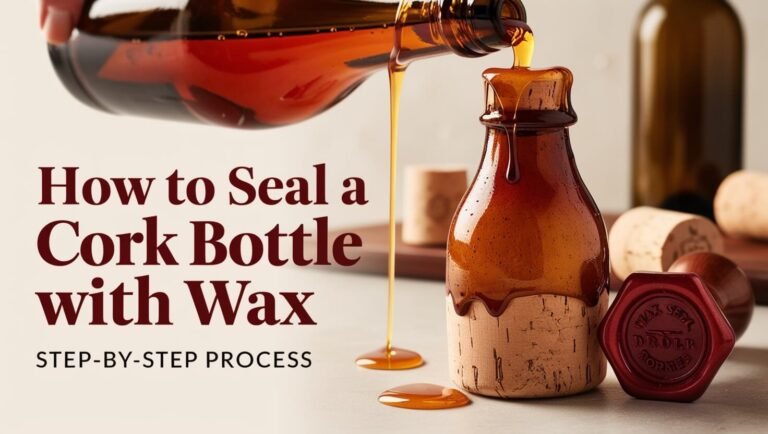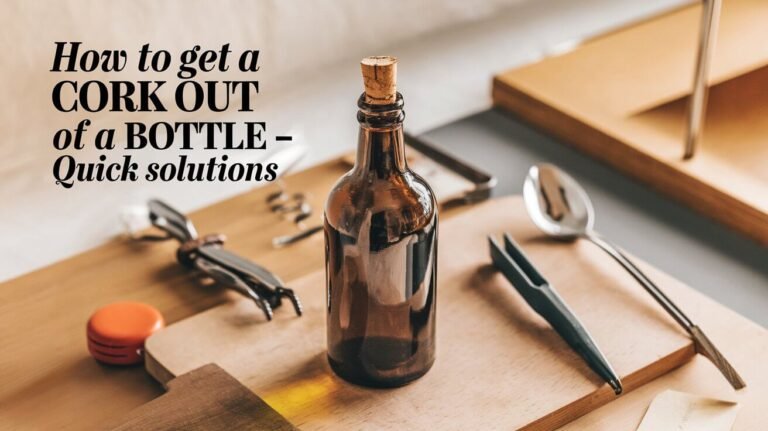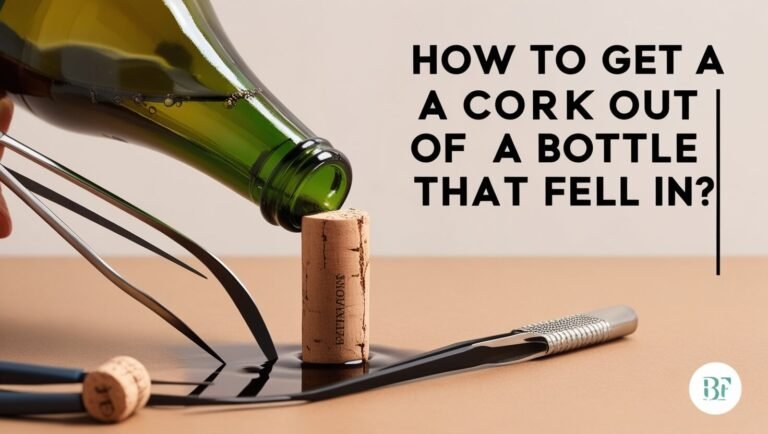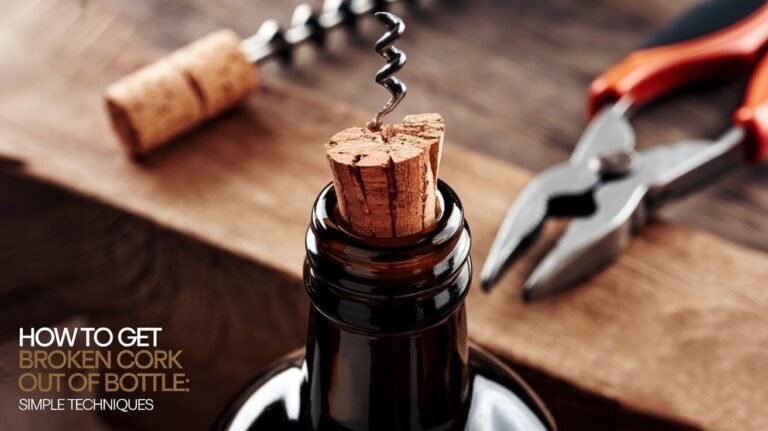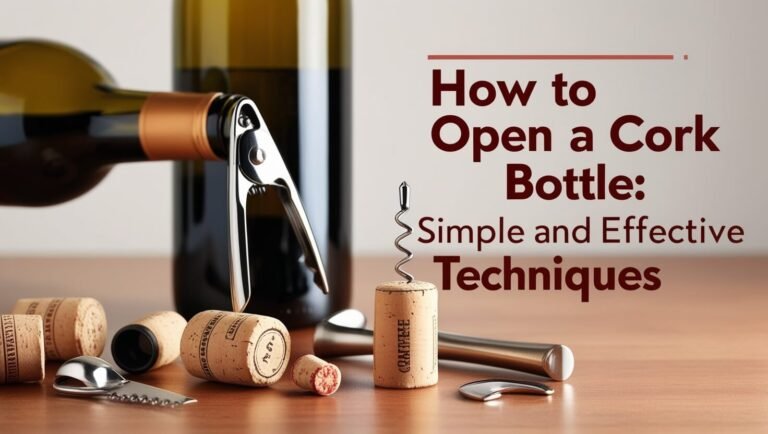How to Get a Cork Back in the Bottle – Easy Tips
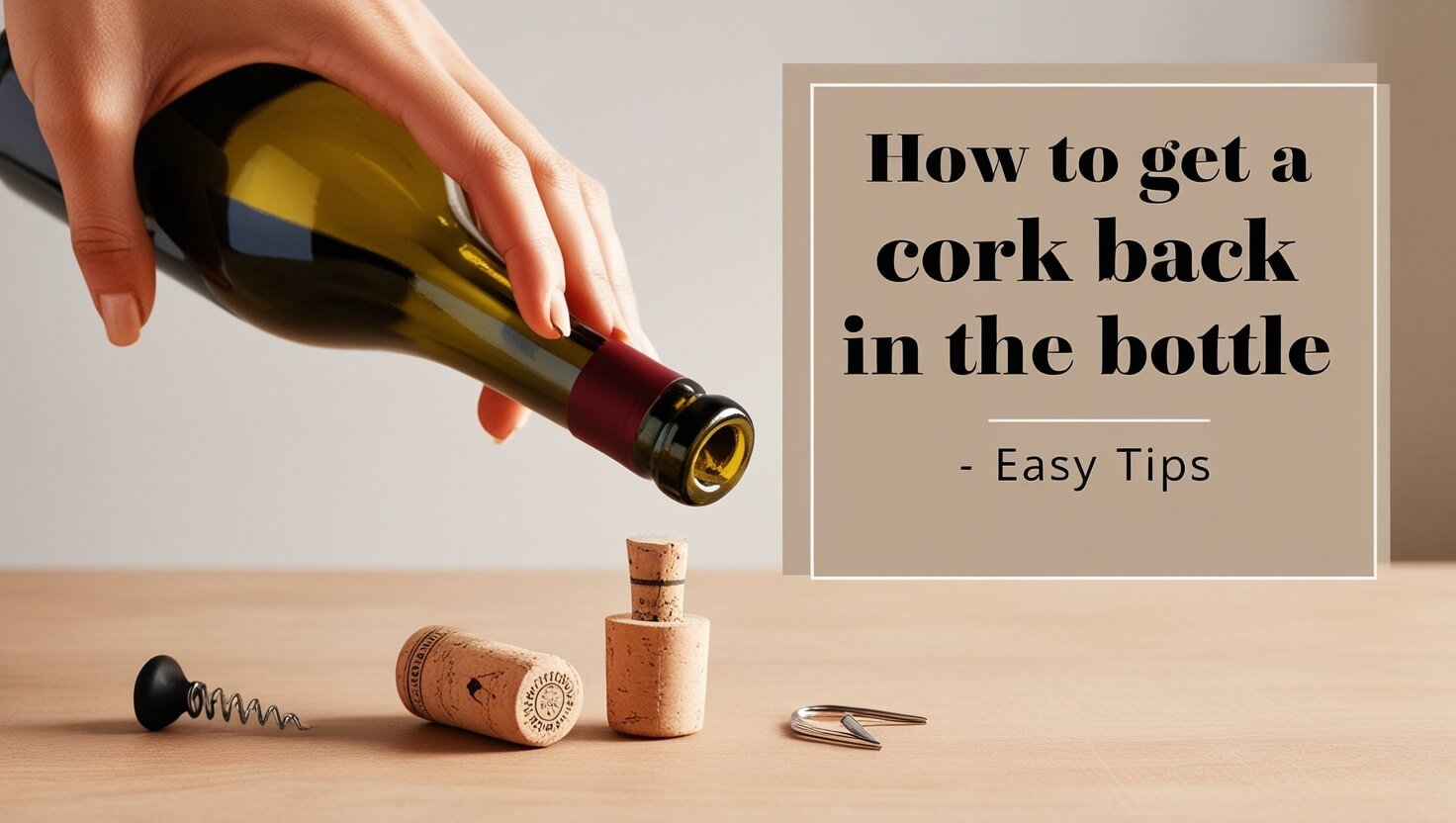
Ever opened the wrong bottle of wine by mistake? Or found yourself with leftover bottles from a party? Recorking wine is key to keeping your favorite wines fresh. But what if you can’t find the cork or it won’t fit? Don’t worry, we have simple ways to get that cork back in.
Common Reasons for Recorking Wine Bottles
Recorking wine bottles is key to keeping wine fresh and tasting great. It’s needed when you’ve only had a bit of wine, if a bottle gets opened by accident, or if you have leftover wine from a party. This action stops the wine from getting stale and losing its flavor and smell.
Preserving Partially Consumed Bottles
If you haven’t finished a bottle of wine, it’s important to seal it up again. An open bottle can last 3-5 days if you reseal it right and keep it in a cool place. This way, you can enjoy the rest of the wine later.
Fixing Accidental Bottle Openings
Wine bottles can get opened by mistake. If this happens, you need to cork it back up fast. This stops the wine from getting too much air and keeps it tasting good for a while longer.
Storing Unused Wine from Events
At parties or gatherings, you might have wine left over. Recorking and storing these bottles helps keep the wine fresh for later. It’s a smart way to enjoy your wine again without wasting it.
| Wine Type | Oxidation Rate |
|---|---|
| Older Wines (over 8-10 years) | Faster |
| Pinot Noirs | Faster |
| Light-Colored Red Wines | Faster |
| Organic White Wines | Faster |
Knowing why you need to recork wine bottles helps you keep your wine tasting good. This way, you can enjoy it even after you’ve first opened it.
Essential Tools for Successful Cork Reinsertion
Having the right tools is key for cork replacement methods and recorking tools. They help when you’re saving a bottle or fixing a spill. These tools make putting the cork back in easy.
The original cork is the main thing. Natural corks let a bit of air in, which helps the wine age well. Synthetic corks seal better, and glass corks keep the air out, perfect for long storage.
Wax paper helps by reducing friction when putting the cork back. Rubber stoppers also work well, keeping the wine fresh.
Wine vacuum pumps remove air, slowing down the wine’s aging. This keeps the taste and smell of the wine better.
Make sure the cork diameter fits the bottle neck well. The cork length should reach the bottom of the neck. Soaking the cork in water and using olive oil or petroleum jelly can help it fit better.
With the right cork replacement methods and recorking tools, you can keep your wine bottles sealed. This way, you can enjoy your favorite wines for longer.
How to Get a Cork Back in the Bottle
Recorking a wine bottle is a delicate task. But with the right technique, you can seal your wine again. The tilt and twist method is simple and works well. It keeps your wine fresh and enjoyable.
The Tilt and Twist Technique
To start, place the wine bottle on a flat surface. Clean the cork by wiping it gently. Then, position the cork at an angle with the bottle’s opening.
Slowly push the cork into the bottle while twisting it clockwise. Use gentle but firm pressure until it’s halfway in.
Proper Cork Positioning
It’s important to position the cork correctly. It should be straight and centered. This ensures a tight seal and keeps air out.
Surface and Grip Requirements
A stable, non-slippery surface is key. The bottle must be firmly on the surface. This lets you apply the right pressure and control.
Also, keep a firm grip on the cork. This helps guide it smoothly back into the bottle.
With practice, you can get good at cork retrieval tips and uncorking and recorking wines. Your partially consumed bottles will stay fresh and ready to enjoy.
The Wax Paper Method for Smooth Cork Insertion
Reusing wine corks is a green and handy way to seal bottles. But, getting the cork back in can be hard. The wax paper method makes it easier.
Wax paper acts as a lubricant. Cut a square, wrap it around the cork, and place it at an angle on the bottle. Press it in gently without twisting. This way, the cork goes in smoothly, without tearing.
- Cut a square piece of wax paper, large enough to wrap around the cork.
- Wrap the wax paper around the bottom and sides of the cork.
- Position the wrapped cork at a slight angle over the bottle’s opening.
- Gently press the cork back into the bottle, avoiding any twisting motion.
This easy trick makes cork insertion simpler, even with tough corks. The wax paper lubricates, ensuring a tight seal. This keeps your wine fresh for longer.
| Benefit | Description |
|---|---|
| Smooth Insertion | The wax paper acts as a lubricant, allowing the cork to slide back into the bottle without resistance or damage. |
| Secure Seal | The wax paper helps the cork fit snugly into the bottle, creating an airtight seal to prevent oxidation. |
| Versatile Application | The wax paper method can be used with a variety of cork types, making it a reliable technique for cork reinsertion techniques and reusing wine corks. |
Learning the wax paper method keeps your wine fresh longer. It’s a key skill for any wine lover.
Signs of Cork Damage and When to Avoid Reusing
Checking the cork before putting it back is key to keeping your wine fresh. Look for crumbling, cracks, or other damage. Damaged corks can’t seal the bottle well, leading to wine cork removal and contamination.
Identifying Cork Deterioration
Check the cork for wear and tear. A good cork is flexible and has a smooth texture. If it’s dry, brittle, or has cracks, don’t reuse it. These problems can ruin the cork replacement methods and affect the wine’s taste and freshness.
Risk Assessment for Wine Quality
- Damaged corks let air in, causing the wine to oxidize and lose its taste.
- Crumbling corks can add off-flavors or debris to the wine.
- Bad seals can cause leakage, leading to wine loss and contamination risk.
If the cork is damaged, look for other ways to seal the bottle. Wine stoppers or preservation systems can help keep the wine fresh. Keeping the seal tight is vital for the wine’s quality and smell.
Alternative Wine Bottle Sealing Solutions
Once a wine bottle is opened, time is of the essence. Oxygen can quickly change the taste, making it vinegary. Luckily, there are ways to keep opened wine bottles fresh.
Stainless steel wine bottle stoppers are a great choice. They expand to seal the bottle tight, keeping the wine fresh. Rubber stoppers are also good, as they can be used many times.
If you don’t have a stopper, a rolled paper towel in plastic can work. It’s not as good as a proper stopper, but it helps a bit.
For longer storage, a wine preservation system is best. It uses a vacuum pump to remove oxygen, keeping the wine fresh for days.
Keeping opened wine bottles fresh is all about the right storage and sealing. With these solutions, you can enjoy your wine longer, without losing its taste or smell.
Professional Wine Preservation Systems
Professional wine preservation systems offer new ways to keep open bottles fresh. They help wine lovers and businesses enjoy their wine longer. This means you can enjoy the taste of your wine for more days.
Vacuum Pump Technologies
Vacuum pump systems, like the Vacu-Vin, are a top choice. They remove air from the bottle, slowing down the process that makes wine go bad. Experiments show wines can stay fresh for about five days with these systems.
Inert Gas Preservation Methods
Inert gases, like argon or nitrogen, are also used to keep wine fresh. The Repour and Coravin Timeless systems use these gases to protect the wine. The Repour is for single bottles, while the Coravin Timeless can keep wine fresh for weeks, months, or even years.
The Coravin Pivot+ system is great for keeping wine fresh for up to four weeks. It’s perfect for casual drinkers, families with different tastes, and restaurants. It uses a thin needle to take wine without removing the cork. This can cut down on waste and boost sales by up to 40% in the food and alcohol industry.
Time Limits for Storing Recorked Wine
Understanding the time limits for storing recorked wine is key to keeping it fresh. Properly recorked wine can last 3-5 days. But, the exact time depends on the wine type, storage, and how it’s sealed.
Sparkling wines and champagnes need special care to keep their fizz. They usually last 1-3 days after recorking. Wines with less sulfur preservatives might turn vinegary faster, so drink them sooner.
The storage environment is also important. Warmer and less stable places can spoil recorked wine bottle sealing faster. Store open wine bottles in a cool, dark spot, like the fridge, to keep it fresh.
To store wine longer, move it to a smaller bottle. This reduces oxygen exposure and keeps it fresh longer. Using vacuum pumps and rubber stoppers can also help keep your recorking wine bottles fresh.
| Wine Type | Typical Shelf Life After Recorking |
|---|---|
| Red Wine | 3-5 days |
| White Wine | 3-5 days |
| Rosé Wine | 3-5 days |
| Sparkling Wine/Champagne | 1-3 days |
These are general guidelines. The actual time for your recorked wine may vary. By knowing the time limits and using best practices, you can enjoy your wine for as long as possible.
Proper Storage Conditions After Recorking
Keeping the right storage conditions is key to keeping your wine fresh after recorking. To keep your wine tasting great, follow these important tips:
Temperature Control Tips
The best temperature for storing recorked wine is between 55-59 degrees Fahrenheit. This slows down aging and prevents oxidation. Try not to change the temperature too much, as it can affect taste and smell.
Position and Light Exposure Guidelines
Keep your recorked wine bottles standing up to keep the cork moist. This stops air from getting in. Also, avoid direct light, as UV rays can spoil the wine faster. Try to keep it away from vibrations too, as they can change the flavor.
By following these easy storage tips, you can keep your recorked wine bottles tasting good for longer. This way, you can enjoy every last drop.
Wine Types Most Sensitive to Recorking
Recorking wine bottles is key to keeping certain wines fresh. But, not all wines handle it the same way. Some are more delicate and need extra care.
Older wines, over 8-10 years, are very sensitive to air after opening. Wines like Pinot Noir and organic whites can also spoil quickly. They need careful handling when recorking.
Sparkling wines, like champagne, lose their fizz fast if not recorked often. Sweet wines are also at risk because of their sugar content. They need to be recorked to stop air from causing spoilage.
But, some wines, meant for aging, actually get better with a bit of air. Recorking them right is important to keep their quality. This helps them age as they should.
For everyday wines, only re-cork if you see signs of cork damage. Wine stoppers or preservers can also help keep the wine fresh. They fight off oxidation.
Advanced Cork Replacement Methods for Vintage Wines
For valuable or vintage wines, advanced methods are needed to keep them fresh. The Coravin System is a new way to enjoy wine without taking out the cork. It uses a thin needle to take out wine and put in gas, keeping the wine’s quality.
This system is great for those who collect rare wines. It lets them keep their wines safe and sound for a long time. This way, they can enjoy their wines without losing their quality.
The Coravin is better than old ways of replacing corks. It doesn’t let the wine’s taste change or get spoiled. This is perfect for old wines, where the cork might have dried out.
By not removing the cork, the Coravin keeps the wine’s special taste. It lets wine lovers enjoy their wines slowly and carefully.
Even though the Coravin isn’t for every wine, it’s a big step forward. It helps wine lovers keep their favorite wines safe. They can enjoy their wines for years to come.
Most Popular Questions:
How do I get a cork back in the bottle?
To put a cork back in a wine bottle, try the Tilt and Twist method. You can also use wax paper to help it slide in. Make sure the cork fits right and press it in slowly and evenly.
Why would I need to recork a wine bottle?
You might need to recork a bottle for a few reasons. It could be to keep wine from going bad, fix a bottle that’s been opened by accident, or to store wine from events. Recorking helps keep the wine fresh by stopping air from getting in.
What tools are needed for successful cork reinsertion?
You’ll need a few tools to recork a bottle. These include the original cork, wax paper, rubber stoppers, and vacuum pumps. These tools help reduce friction, seal the bottle tightly, and remove air to slow down oxidation.
How do I use the Tilt and Twist technique to reinsert a cork?
The Tilt and Twist method starts with the bottle on a stable surface. Clean the cork and place it at an angle over the bottle. Then, twist it in slowly to get it back in.
How can wax paper help with cork insertion?
Wax paper can make it easier to get the cork back in. Just wrap the cork in wax paper and place it at an angle. Press it in gently without twisting to avoid tearing the paper.
When should I avoid reusing a cork?
Don’t reuse a cork if it’s damaged. Look for crumbling, cracks, or other damage. Damaged corks can’t keep the wine fresh and might add debris to the bottle. If the cork is bad, use another way to seal the bottle.
What other options are there for sealing wine bottles?
There are other ways to seal a wine bottle. You can use stainless steel stoppers, rubber stoppers, or even a paper towel cork. These can work if you can’t use the original cork.
How long can I store recorked wine?
Recorked wine can last 3-5 days, depending on the type and how you store it. Things like temperature, light, and air all affect how long it stays good after opening.
How should I store a recorked wine bottle?
Keep recorked bottles upright to keep air out. Put them in the fridge to slow down oxidation. Keep them away from light and extreme temperatures. Let red wines warm up a bit before drinking.
Which wines are most sensitive to recorking?
Some wines, like older vintages and Pinot Noirs, are more sensitive. Light-colored reds and organic whites are also at risk. Be extra careful when recorking and storing these wines.
What are advanced methods for preserving vintage wines?
For expensive or rare wines, consider using a Coravin. It lets you taste wine without removing the cork. This keeps the wine fresh for a long time.

